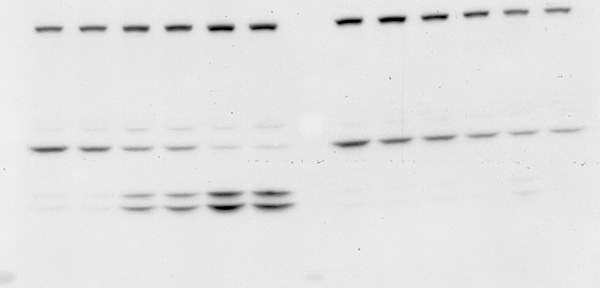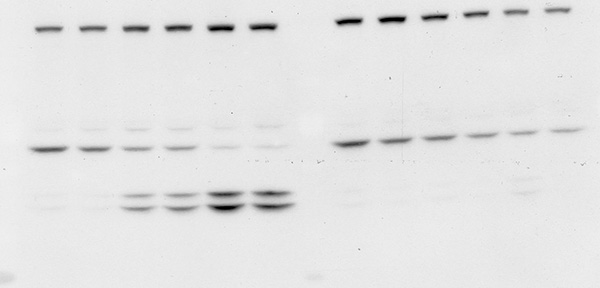
Primary antibodies are used to detect the protein of interest. Part 5 of the Western blotting guide details appropriate methods to encourage the primary antibody to perform optimally and that your Western blot performs efficiently.

Overview
The primary antibody is the reagent used to detect the protein of interest. Added after membrane blocking, the primary antibody binds specifically to the protein of interest. The membrane is incubated with the primary antibody at room temperature (1 hr is commonly used) on a rocker or shaking platform, although overnight incubations at 4°C may also be effective. Following incubation, with the primary antibody the membrane is washed to remove any excess and unbound antibody. This maximizes the sensitivity of this technique and increases the signal-to-noise ratio.
Considerations for Selecting a Primary Antibody
There is a wide range of primary antibodies available commercially in different formats, clonality and specificity, which are important factors to consider when selecting an appropriate reagent.
Specificity – Immunogens
The type of immunogens used to produce the antibody dramatically influences the specificity of the antibody for the target protein. Choosing an antibody raised against an unsuitable or poor quality immunogen will lead to unreliable and potentially irreproducible results. Care should be taken to select antibodies raised against well-characterized immunogens.
Peptides
Synthetic peptide immunogens rarely fold into the comparable tertiary structure of the native protein. In addition, unless added to the peptide during synthesis, they do not exhibit any post-translational modifications. Therefore, antibodies generated using peptides can be useful reagents for western blotting as target proteins have linearized epitopes due to denaturation and reduction during sample processing. Peptides can also be useful as immunogens when an antibody needs to differentiate between two proteins having highly conserved amino acid sequences. In those cases, peptides generated to the regions of difference increase the possibility of making a differentiating antibody.
Native Proteins
If purified proteins are used as an immunogen, the antibodies generated against them may not recognize the linearized epitopes of the denatured proteins in western blotting. Some antibodies raised using native protein will only recognize the epitopes on the surface of a protein in its native, oxidized conformation. This is especially true of monoclonal antibodies.
Host Species of the Primary Antibody
Ideally, the primary antibody should be raised in a different species than the sample to be analyzed. This is to avoid the secondary antibody detecting immunoglobulins from the sample if present. For example, a sample from mouse may contain mouse immunoglobulins. If the primary antibody is also made in mouse, an anti-mouse secondary antibody will detect not only the primary antibody binding to the protein of interest but also to the heavy and light chains of the immunoglobulin in the mouse sample. This can be particularly problematic when the protein of interest has a molecular weight that is similar to either that of the heavy chain (50 kDa) or the light chain (25 kDa), as differentiation between the protein of interest and endogenous mouse IgG becomes impossible.
Monoclonal and Polyclonal Primary Antibodies
Both monoclonal and polyclonal antibodies can be used for western blotting. Monoclonal antibodies are produced from a single clone of B cells and produce antibodies specific to one epitope. Whereas polyclonal antibodies are produced from differing B-cell lineages and so contain multiple clones recognizing different epitopes on the antigen. Both types have benefits and limitations (which are shown in the table below).
| Description | Advantages | Disadvantages | |
|---|---|---|---|
| Monoclonal | Produced from a single B-cell lineage – specific to one epitope on an antigen. | High specificity, batch-to-batch consistency and are often well characterized. | Possible lower sensitivity due to reduced binding affinity for epitopes compromised by sample preparation/electrophoresis. |
| Polyclonal | Produced from differing B-cell lineages – recognize multiple epitopes on the antigen. | High sensitivity from signal amplification and detection of multiple epitopes. | Specificity relies on quality immunogens, and may suffer from batch-to-batch variability. |
Primary Antibody Diluent
The working solution of the primary antibody is usually made by diluting it using either TBS (Tris-Buffered Saline) or PBS (Phosphate-Buffered Saline). It is essential that the buffer maintains the antibody’s biological activity; therefore, the manufacturer’s recommendations should be followed. Buffers containing detergents (TBS-Tween or PBS-Tween) which are used in washing steps, are also suitable as antibody diluents. As mentioned in Section 4, avoid PBS when detecting phosphorylated proteins because phosphate ions can interfere with the antibody binding.
Caution: Primary antibody diluent bufferAvoid adding proteins such as powdered milk or BSA to antibody diluent solutions to prevent non-specific interactions that may lead to background signal. |
The concentration of the working antibody solution should be optimized for efficient detection of target protein. Dilute solutions risk not saturating target protein, resulting in low signal. Overly high concentration solutions are not only wasteful but can lead to non-specific bands, high background, or excessive signal intensity.
Titrate Your AntibodiesIt is good practice to titrate antibody concentrations to determine optimal working concentration. Use two-fold dilutions either side of the manufacturer’s recommendations to identify the optimum antibody concentration for the specific western blot that is being performed. Higher temperatures, and longer incubation times, increase the incidence of binding events, both specific and non-specific. Conventionally the membrane is typically incubated with the primary antibody solution for one hour at room temperature or 4°C overnight on a rocker or shaking platform. |
Reprobing and stripping for additional target proteins
Membranes may be stripped to remove the primary and secondary antibody complex and reprobed with a second pair of antibodies to allow the detection of a second target protein. The membrane is stripped with a low pH buffer such as 1M glycine to remove the primary and secondary antibody complex from the antigen bound to the membrane. The membrane is then blocked and incubated with a new primary antibody, washed and incubated with a compatible secondary antibody and substrate before being reimaged.
The success of stripping can be highly variable, and must be carefully performed to prevent either being too harsh and damaging the antigen. Alternatively, conditions too mild to strip the antibody complex from the membrane may lead to continued detection.
The results of a reprobed blot should only be used for confirmation, not for quantitation. Choosing a second primary antibody raised in a different host to the initial antibody can help improve specificity of the reprobing. Stripping and reprobing membranes for additional targets are typically applied in chemiluminescent detection, as fluorescent conjugates offer a more reliable method for detecting multiple targets, see Section 8 for more information about multiplex detection.
Considerations for Antibody Validation
Each primary antibody must perform as expected, detecting the protein of interest under the experimental conditions. Ideally, suitability for the experiment would be validated for each primary antibody and protein pair for each new experimental setup. Four aspects of primary antibody performance should be addressed during the validation processes. These are:
- Specificity to the antigen/protein of interest
- Specificity to the antigen under experimental conditions (native or denatured)
- Affinity for the antigen
- Reproducibility
Specificity to the antigen/protein of interest
Use negative and positive controls to establish that a primary antibody is specific to the protein of interest, ideally using purified and/or control material. It is important to include a blank sample or negative sample control to establish if the primary antibody detects endogenous proteins.
Specificity to the antigen under experimental conditions (native or denatured)
It is important to establish if a primary antibody is suitable for the detection of the target protein under the experimental conditions. This may be because a primary antibody that is suitable for use in IHC, where antigens are in their native forms, may not be able to detect the linearised antigens of proteins in western blotting and vice versa.
Affinity for the antigen
Although a primary antibody may detect the protein of interest specifically or across a range of techniques, it may not have sufficient affinity to produce a signal brighter than background.
Reproducibility
One of the problems that can be encountered with primary antibodies is the difficulty in replicating results. This may be because of batch-to-batch variability or poorly characterized specificity.
A recent movement in life-science research has been to encourage manufacturers to validate their antibodies and confirm detection of stated target antigens in specific applications. In an effort to improve and promote research resource identification, discovery, and reuse, the Resource Identification Portal was created in support of the Resource Identification Initiative. Research Resource Identifiers (RRIDs) are assigned to research materials and are unique identifiers allowing researchers to trace materials.
Specific to antibodies, the Antibody Registry catalogs antibody RRIDs to clarify their use in published literature.
Ideally, a researcher should confirm the product performs reliably, preferably using a positive control in the technique desired.
Controls
Positive control
Most primary antibodies are available with a positive control from purified protein. These controls can be run in parallel with the sample and the migration of the protein compared to the bands detected from the sample.
Tissue controls
If possible, a positive tissue control is used to determine antibody specificity and performance in detecting processed proteins. The specificity of the antibody is confirmed using cells or tissue samples known to express the protein of interest. A band observed at the expected weight provides a positive indication of antibody specificity. A negative tissue control is useful to determine non-specificity of the primary antibody. A sample of tissues or cells known not to express the target protein is probed with the primary antibody. An absence of bands is desired; any non-specific detection of proteins in the sample can indicate detection of endogenous proteins.
Negative or secondary antibody control
A secondary antibody control is simply the probing of the membrane without the primary antibody. This can be used to confirm if blocking/washing of membrane has been adequate and identify any background signal generated by the secondary antibody.
StorageManufacturer’s guidelines should be followed for Primary antibody storage. Generally speaking, Primary antibodies should be aliquoted and frozen in single-use volumes, and working solutions should be made up fresh on the day of intended use to avoid multiple freeze-thaw cycles. |
Found Part 5 of our Western blotting guide useful? View part 6 here
References
- Blancher C. et al. (2001). SDS-PAGE and Western Blotting Techniques. Methods in Molecular Medicine. doi: 10.1385/1-59259- 136-1:145.
- Jackson ImmunoResearch Laboratories Inc. (2017). Western Blotting Troubleshooting Guide! https://www.jacksonimmuno.com/secondary-antibody-resource/technical-tips/western-blot-trouble-shooting/
- GE Healthcare. (2011). Western Blotting Principles and Methods. https://www.sigmaaldrich.com/content/dam/sigma-aldrich/docs/Sigma-Aldrich/General_Information/1/ge-western-blotting.pdf
- Bass J.J. et al. (2017). An Overview of Technical Considerations for Western Blotting Applications to Physiological Research. Scandinavian Journal of Medicine and Science in Sports. doi: 10.1111/sms.12702
- Lewis M. (2018). A Guide to Selecting Control and Blocking Reagents. Jackson ImmunoResearch Laboratories Inc. https://www.jacksonimmuno.com/secondary-antibody-resource/technical-tips/controls-diluents-blocking/
- Kelly M.F. et al. (2016). Antibody Validation. Mater Methods. doi.org/10.13070/mm.en.6.1540
- Lewis M. (2018). Cross-Adsorbed Secondary Antibodies and Cross-Reactivity. Jackson ImmunoResearch Laboratories Inc.https://www.jacksonimmuno.com/secondary-antibody-resource/technical-tips/cross-adsorbed-and-cross-reactivity/
- Baker M (2015) Reproducibility crisis: Blame it on the antibodies Nature. 19th May 2015
- Bradbury & Plückthun (2015) Reproducibility: Standardize antibodies used in research. Nature. 04 February 2015
- Bordeaux et al. (2010) Antibody validation Biotechniques. 2010 Mar; 48(3): 197–209.
- EMBO meeting 2016: Lex Bouter, The replicability crisis.
| Learn more: | Do more: |
|---|---|
| Colorimetric western blotting | Spectra Viewer |
| Chemiluminescence western blotting | Antibodies for signal enhancement |
| Fluorescent western blotting | |



